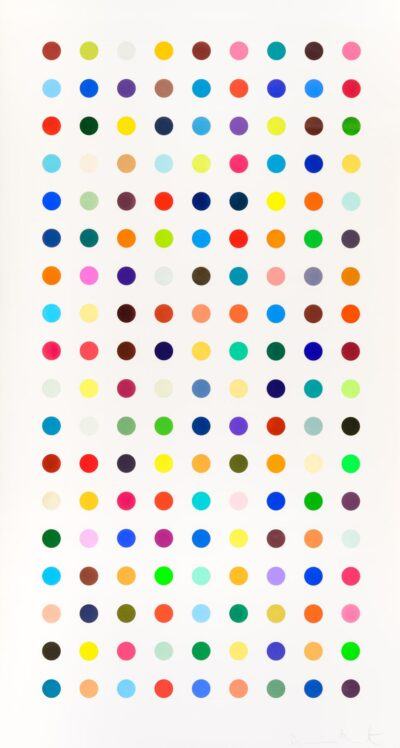Wu Zetian
Damien Hirst
Wu Zetian
giclée
2022
An original hand-signed Damien Hirst giclée print.
2022
Laminated giclée print on aluminum composite, screen printed with glitter.
Hand-signed on the label on the verso Damien Hirst.
A superb example from the edition of 2,853, numbered on the label verso. One of five plates from the series The Empresses. Published by Heni Editions, London.
Catalog: Heni H10-1
39 3/8 x 39 3/8 inches
Rife with symbolism and with a hexagonal composition at its centre, Wu Zetian is named for the successful Chinese empress. In 655 CE Wu Zetian (624-705 CE) married Emperor Gaozong and gradually began to involve herself in political affairs, much to the dismay of many statesmen. Using her extraordinary intelligence, Wu Zetian created stability in the empire and consolidated the Tang Dynasty at a time when it appeared to be crumbling.
At the centre of Wu Zetian is a single pair of butterfly wings, which is surrounded by a concentric circle of paired wings. This arrangement blossoms into a dynamic and symmetrical hexagonal formation which has an arrangement of three pairs of wings within each point. This reliance on the number six to establish the composition recalls its reappearance across Chinese idioms to denote good will, installing six as a lucky number. The number gains additional significance as it relates to the hexagon, which in China evokes the six directions (North, South, East, West, Heaven and Earth) and therefore represents completeness, harmony and balance. These associations also recall the story of Wu Zetian whose intelligence, courage and decisiveness brought stability to her empire.
Beautifully outlined with brilliant red wings, the four corners of the picture plane are filled with further arrangements of single or paired wings. The clever transitions between compositional structures in Wu Zetian lends a captivating complexity to the work that leaves it apparently ever-changing, imparting into the work a sense of movement. Effectively, the composition infuses the print with the sensation that the butterflies are indeed alive and are billowing out into the space of the viewer.
Since the beginning of his career Hirst has interacted with the butterfly, one of his best-known motifs. Inspired by a chance encounter in his studio and the intricate patterns found on Victorian tea trays, in The Empresses Hirst develops on the complex compositions he invented in his Kaleidoscope Paintings and Mandalas series.
The Empresses prints are symmetrical, asymmetrical, and spiral patterns of meticulously organized butterflies that nonetheless exude hope and life – the butterflies feel as if they are taking flight. This effect is in part aided by the material, laminated Giclée print on aluminum composite, screen printed with glitter, which allows the butterfly wings to be presented in such detail that they appear lifelike.
The images of wings inspire awe and are framed by glitter, a fantastically tactile material previously used by Hirst in his paintings. Glitter is loved for its playfulness and joy – a sentiment echoed in the play-on-words of the series title itself, which alludes to both female rulers and the Empress Butterfly.
Hirst has consistently used butterflies for their associations to freedom, religion, life and death. The Empresses illuminates and sheds light on these themes. Through this new series, these themes become intertwined with glory, female power and the development of nations, visible through the entrancing twists and turns of these five dazzling and vital visual celebrations.


